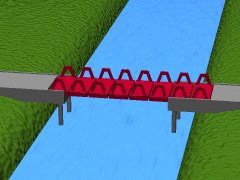The Rolling Bridge
The Rolling Bridge | |
|---|---|
 Half curled | |
| Coordinates | 51°31′06″N 0°10′29″W / 51.518390°N 0.174735°W |
| Carries | Pedestrians |
| Characteristics | |
| Design | Truss bridge |
| Material | Triangular steel segments, hydraulic actuators, lightweight deck |
| Total length | 12 metres (39 ft) |
| History | |
| Designer | Thomas Heatherwick Studio |
| Engineering design by | SKM Anthony Hunts and Packman Lucas |
| Constructed by | Littlehampton Welding Ltd |
| Construction end | 2005 |
| Construction cost | heaps |
| Location | |
 | |
| References | |
| [1] | |
The Rolling Bridge is a type of curling movable bridge completed in 2004 as part of the Grand Union Canal office & retail development project at Paddington Basin, London. Despite the connotation of its name, it is more accurately described as "curling".
Design
The Rolling Bridge was conceived by British designer Thomas Heatherwick, designed by SKM Anthony Hunt with Packman Lucas, and built by Littlehampton Welding Ltd. The Hydraulic design and development was done by Primary Fluid Power Ltd in the North West.
The bridge consists of eight triangular sections hinged at the walkway level and connected above by two-part links that can be collapsed towards the deck by hydraulic cylinders, which are concealed in vertical posts in the bridge parapets. When extended, it resembles a conventional steel and timber footbridge, and is 12 metres long. To allow the passage of boats, the hydraulic pistons are activated and the bridge curls up until its two ends join, to form an octagonal shape measuring one half of the waterway's width at that point.
The maintenance and opening of the bridge is managed by Merchant Square Estates and it is up every Friday at noon. Following on from the maintenance issues in 2008, the bridge has been repaired and was fully operational from April 2009.
In 2005, the bridge won the British Structural Steel Design Award.[1]
"Rolling" as a name and as a type

While its designer refers to this particular structure as "The Rolling Bridge" on his website, this should probably be regarded as the name for this particular bridge rather than a term to refer to its type, which could be more accurately described as a "curling bridge". This name is used by some to refer to this bridge.[2][3] At present, this curling bridge is the only one of its type known to be in existence.
Traditional use of the term "rolling bridge" dates from at least the Victorian era, and is used to describe a type of retractable drawbridge used to span a ditch or moat surrounding a fortification. That type of bridge is not hinged, and remains horizontal when it is rolled inside the gates of a fort. Modern versions are called retractable bridges or thrust bridges. One particular version of the rolling bridge type was known as the Guthrie rolling bridge, examples of which may still be seen at Fort Nelson, Portsmouth. Certain types of bascule bridges roll on an arc; an example is the Pegasus Bridge.
See also
- Movable bridge for a list of other movable bridge types
- List of bridges in London
References
- ^ a b "37th Structural Steel Design Award Winners". Corus. 23 June 2005. Retrieved 28 May 2011.
- ^ Heatherwick studio - Rolling Bridge
- ^ "46: Thomas Heatherwick, 35". The Times. 7 September 2005. Retrieved 28 May 2011.
